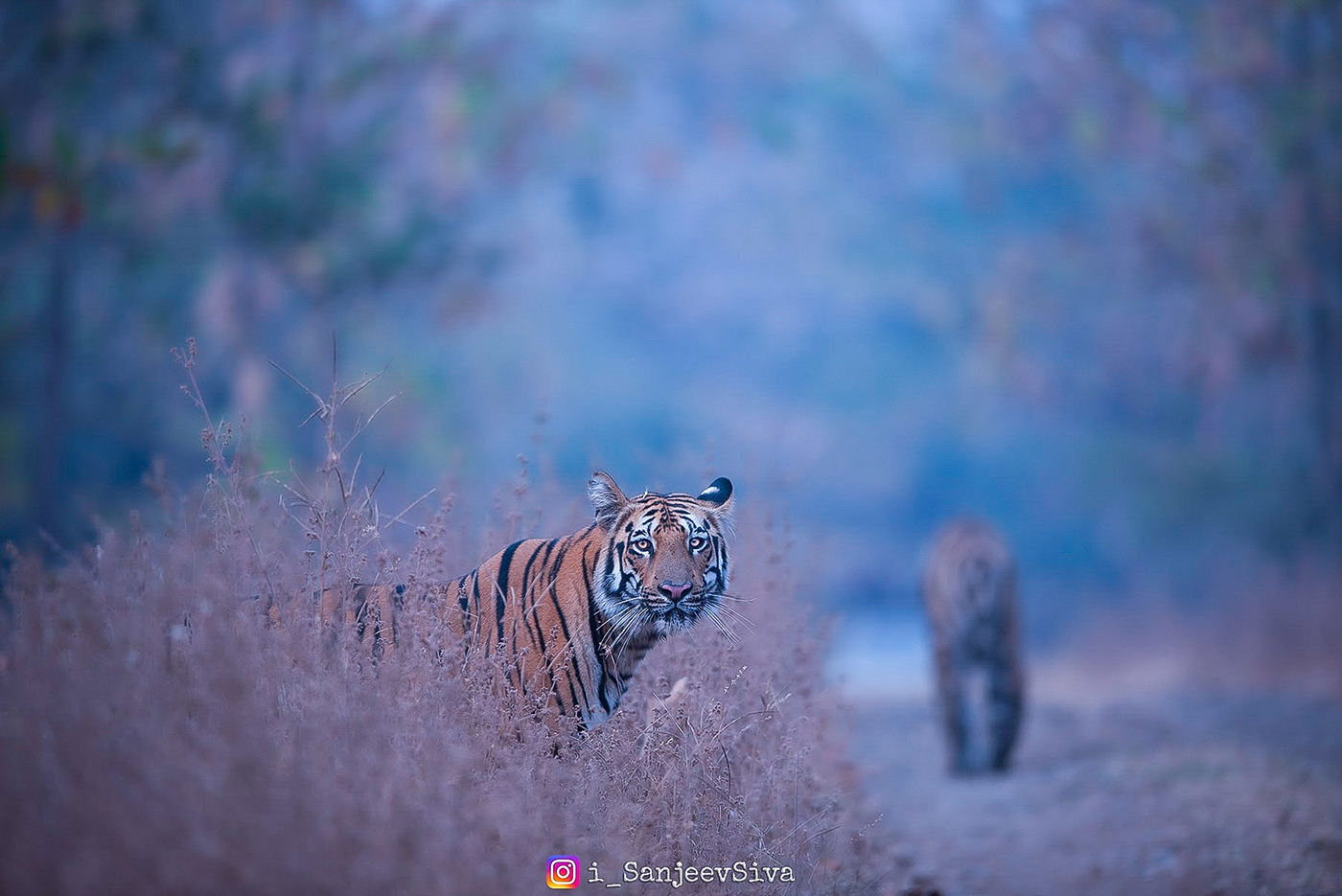Tipeshwar – A microcosm
By 1990s, much of the tiger population is wiped from the known wildlife reserves due to a lone reason – anthropogenic activity inducing biotic stress. Human settlements increased manifold, inside and on the fringes of the forests, over the past few decades and this led to a fragmentation of forests. At a micro-level, each forest faces the same issues, which the total forests and corridors face at a macro-level.
One such forest is Tipeshwar, a microcosm of the tiger world. Located along the borders of Telangana and Maharashtra, Tipeshwar is a small wildlife sanctuary of area 148.63 sq. Km, which derives its name from Goddess Tipai, enshrined in a temple atop a hillock.
Tipeshwar emerged into a successful tiger-cradle in the Eastern Vidarbha Landscape (one of the prominent Tiger Conservation Landscapes of India) and has a very good potential to populate nearby reserves such as Kawal of Telangana (which despite having an aggregate area of 2000 sq. Km has only a handful of tigers). But Tipeshwar is plagued by all the problems any tiger forest has – it is right in the middle of densely populated and human dominated landscape with problems at the fore such as human activity – poaching, cattle grazing, trespassing etc., development – illegal mining, highway expansion etc., forest and prey-base degradation, human-tiger conflict.
Earliest known records of tigers point to rampant poaching (of deer, wild boar and even bigger predators such as the tiger).
On 20thNovember 2011, a resident male tiger was poached close to Bothgaon village in Patanbori range (along the fringes of the sanctuary). On 8th March 2012, the remains of another tiger were discovered within the sanctuary.
By 2010, only 3 tigers were known to inhabit the forests of Tipeshwar. There were not any records of tigers earlier (which necessarily does not rule out a tiger presence. Owing to extensive tourism and the camera-trapping done to survey tiger numbers, we are aware of tiger presence with a good coverage of tiger sites across the country, which was not the case a decade ago).
It is believed that all the tigers in Tipeshwar existing today are from the matriarch (who is still believed to be alive). This matriarch is believed to have given birth to Pilkhan tigress and the Lake tigress (also called Talaowali). The extremely prolific breeders they are, these tigers (and their offspring) have spawned the tiger numbers from the sanctuary to 25 within a span of 6 years; this number not counting the number from the matriarch as not much is known about her.
Two pertinent questions at this stage – how did the tiger numbers explode in such a short span of time, and what happens/happened to these tigers?
Tipeshwar went from being a sink (collecting surplus population) reserve to source (generating tiger numbers) reserve with village relocation playing a particularly important part. The three villages in the sanctuary - Tipeshwar, Pitapingri and Maregaon - mostly dominated by Kolam tribals have been relocated by 2014-15, after a few initial hiccups.
Five tribes occupy the Tipeshwar forest region viz., Pardhan, Gond, Kolam, Navbuddha and Kunbi of which the former three are said to be aboriginal. The total populations of these tribes range from a few hundred to thousand and they are seemingly vanishing; these tribes are stricken with poverty with a high mortality rate in infants, and a high incidence of sickle cell disease (SCD).
The inviolate spaces created for the tigers due to the village relocation, measures such as sambar deer reintroduction etc., helped the tigers promulgate their tribe. But this outwardly radiating population has not necessitated a haven or a safe passage for the tigers (and to the humans in the path of the tiger).
The forest is spread over an area of 148 sq. Km only (which is not contiguous as well), and is surrounded by agricultural fields, human habitations and linear development projects. Well beyond the holding capacity with reduced chances of outward migration, tigers seem to have been stuck in a limbo.
Tigers of Tipeshwar
Pilkhan and Talaowali (lake female) are the oldest tigers (apart from the matriarch), and both courted by Star male, who is the indomitable king of Tipeshwar, around 8 years of age and ruling since quite a while. In addition to being the dominant tiger, he has proved to be a doting father as well and with no recorded scuffles with any of the other males (who are mostly his own sons).
The first of the litters of Pilkhan and Talaowali tigers are supposedly from an old male known as Booddha male.
The first litter of Pilkhan tigress were 4-mark (also called Maregoan tigress), X-mark and H-mark; they were born in 2014. X-mark died during capture and treatment for the removal of a wire-snare around her neck (with which she had been moving around for more than 18 months) on 17th March 2019. H-mark was known to have dispersed from Tipeshwar and seemingly moved south of Tipeshwar.
The second litter of Pilkhan tigress were Jack, Johnnie and Walker, born in 2016. Both Jack and Walker were trapped in snares but were treated successfully later (these snares are laid by poachers to trap wild boars or spotted deer. Tigers are mostly a collateral damage, atleast in Tipeshwar). Walker migrated to Dhyanaganga Wildlife Sanctuary a few hundreds of kilometres north west of Tipeshwar undertaking the longest migration ever recorded of the Royal Bengal Tiger, with almost no incidence of conflict. Johnnie too seemingly moved south of Tipeshwar, while Jack seems to have settled in the northern part of the forest.

The third litter of Pilkhan tigress comprised of 2 males and 2 females, born in 2018. Pilkhan female is known to abandon the cubs even before they reach the subadulthood stage. So, the tigers develop a sibling bond, to hunt and survive. These 2 males were recorded to be moving together (as they approach subadulthood). A similar behaviour was observed even in case of her second litter. 1 female from the third litter is missing since quite a while.
Talaowali gave birth to her second litter in 2016 (not much is known about her first litter). There were two females, Smiley and Archie, and one male, Neo. As Archie entered adulthood, she was seen courting Jack (second litter of Pilkhan), but as of today, there is no info on these tigers (they probably moved out of the park).
The third litter born in 2018 comprised of 2 males and 1 female. Like Pilkhan female, Talaowali too abandoned the cubs before the completion of the infancy stage. The drawbacks of abandonment trickles down to the hunting behavioural skills of the cubs. One or more of the males were injured grievously while trying to take down a porcupine (happened possibly after the mother abandoned the cubs, early on). The tigers were treated, and the males formed a team and were seen together for a long while.
The female cub moved away from its family and was seen along with the contemporary litters of Pilkhan (3rdlitter) and Maregoan (1st litter) tigresses, for a short span of time, much to our awe. Packs and Clans are not a feature of tiger world. Possibly, the sense of independency creeps in only after tigers reach subadulthood (around 2 years of age). The very same female created a conflict situation along the fringe villages of Andharwadi, Kopamandvi, Kobbai and Sunna. In an unfortunate turn of events, this female cub was responsible for the death of the mother of a tiger tracker and guide from the village of Sunna on 18th September 2020. The tigress was captured over the next few days and shifted to Gorewada rescue center, Nagpur (where it will probably spend the rest of its life in captivity).
Maregoan tigress (or the 4-mark female), daughter of Pilkhan tigress, also gave birth to two consecutive litters. The tigers from the first litter I-mark (F), T-mark (F) and Arrow mark (M) seems to have dispersed/whereabouts unknown, while a second litter of 3 cubs is being currently raised by the Maregoan tigress.
What happens to these tigers?
A tigress generally needs around 15-20 sq. Km territory to dominate. Male tigers would need more. Depending on the nature of territory (prey-base rich, water-rich etc.,), more tigers converge around the same area with a substantial overlap. Prey-rich territories have higher tiger densities, but even considering a densely infested forest, Tipeshwar is already beyond carrying capacity.
As mentioned earlier, Tipeshwar, a reserve of source population is surrounded by human habitations and linear development projects. The migration corridors to the nearest tiger reserves such as Tadoba Andhari and Kawal Tiger Reserves are nearly non-existent. Tigers are known to be making inroads to Kawal, but on an infrequent basis.
The long-distance migration of Walker (2nd litter of Pilkhan) blatantly shouts that tigers can discreetly migrate to disconnected forest patches, despite encountering human habitations, roads, railways, irrigation ways etc., in their path. The escalated situation created by the captured female cub (2nd litter of Talaowali), however says that conflict is always on the cards, especially when the cubs are females; because females follow natal philopatry – staying in the same area where they were born and don’t disperse, under normal circumstances, infighting or human-animal conflict are possible outcomes.
In these parts of Vidarbha, along the fringes, farms are fenced and electrified (to keep away wild ungulates such as boars, deer and antelopes that destroy crops). Unassuming bigger predators such as the tigers fall prey to these electric fences. Most times, fear-stricken locals bury these dead animals or poach them.
A few of these tigers, mostly those settling along the fringes become cattle lifters and face the ire of the villagers sooner or later.
The linear development projects create an intangible and unforeseen damage too. For example, the lower Penganga project, 17 KMs from Tipeshwar is supposed to submerge a major portion of the Penganga wildlife sanctuary along the Telangana-Maharashtra border, along with a 1000 hectare of Tipeshwar wildlife sanctuary. A planned 13.5 KM of left bank canal tunnel will as close as 2 KMs of Tipeshwar (the construction of the tunnel will also need considerable blasting and mining which will destroy the fragile ecosystem). All of this in addition to displacing thousands of tribals.
Less than 50% of the project has been completed and for lack of funds/clearances, the project is shelved as of now.
With a few tigers from Tipeshwar moving towards Penganga WLS, canals and the dam will probably create a permanent blockage to tiger movement.
Roadways such as the National Highway NH-7 that has been recently widened to four-lanes, has fragmented the crucial corridor and forest patch used by tigers and other wild animals.
Illegal mining has been rampant too with many mines located in the Eco-sensitive Zone (ESZ) of Tipeshwar, near the Kopamandvi beat and Patanbori/Yedlapur areas of the park. Mining is banned in ESZ and no fresh leases are granted. However, blasting etc., continue to happen to extract gravel. Such activities further reduce the effective area of the park available to wild animals.
Probably, the answer to where the tigers vanish after infancy stage is, they die – unable to find an inviolate territory, and shifting to cattle dependency due to non-availability of wild prey closer to human habitations, getting into conflict with humans or getting ensnared or electrocuted while undertaking migrations through the maze of development projects etc.
Tipeshwar like any source (for tiger population) is a microcosm of tiger conservation for it outlines the rate at which tigers promulgate with lesser human interference/de-fragmentation/relocation and characterizes the impact of the radiating population of tigers on self and on fringes and migration corridors and the necessity of such corridors.
Photographed are Johnnie and Jack from Pilkhan's second litter.
Disclaimer – A lot of information has been collected from various sources, accounts and personal stories. There always is room for discrepancy; please help me correct, if any.
